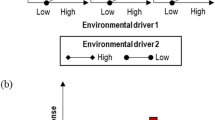Summary
The use of the terms, which have not always been employed uniformly throughout the literature, is discussed and an exact definition is tried. Application of the terms “ultimate” and “proximate factors” should not be restricted to annual and circadian periodicities. Instead they should be used for all temporally or spatially restricted processes for which a difference between selecting and regulating mechanisms is to be found. “Ultimate factors” are environmental factors which in the course of evolution have led, through natural selection, to the relevant restriction. Proximate factors may be defined as those external stimuli which initiate or maintain biological processes under most favourable ecological conditions. The term “Zeitgeber” finally, should only be used where endogenous circadian or circennial periodicities are synchronized with environmental changes through external factors. In this sense “Zeitgeber” is merely a special case of “proximate factor”.
Similar content being viewed by others
Literatur
Aschoff, J.: Zeitgeber der tierischen Tagesperiodik. Naturwissenschaften 41, 49–56 (1954).
Aschoff, J.: Jahresperiodik der Fortpflanzung bei Warmblütern. Studium gen. 8, 742–776 (1955).
Aschoff, J.: Tierische Periodik unter dem Einfluß von Zeitgebern. Z. Tierpsychol. 15, 1–30 (1958).
Ashmole, N. P.: The biology of the Wideawake or Sooty Tern Sterna fuscata on Ascension Island. Ibis 103b, 297–364 (1963).
Baker, J. R.: The evolution of breeding seasons. In: Evolution: Essays on aspects of evolutionary biology, p. 161–177. Oxford: Clarendon Press 1938.
Bongiorno, S. F.: Nest-site selection by adult Laughing Gulls (Larus atricilla). Anim. Behav. 18, 434–444 (1917).
Crook, J. H.: The evolution of social organisation and visual communication in the weaver birds (Ploceinae). Behaviour, Suppl. 10, 1–178 (1964).
Cullen, J. M.: The diurnal rhythm of birds in the Arctic summer. Ibis 96, 31–46 (1954).
Gerlach, S. A.: Tierwanderungen. In: Handbuch der Biologie, Bd. 5, S. 413–472. Konstanz: Athenaion 1965.
Gwinner, E.: A comparative study of circannual rhythms in warblers. In: Biochronometry, p. 405–427. Washington: National Academy of Sciences 1972.
Horn, H. S.: The adaptive significance of colonial nesting in the Brewer's Blackbird (Euphagus cyanocephalus). Ecology 49, 682–694 (1968).
Immelmann, K.: Tierische Jahresperiodik in ökologischer Sicht. Zool. Jb. Abt. System., Ökol. u. Geogr. 91, 91–200 (1963).
Immelmann, K.: Periodische Vorgänge in der Fortpflanzung tierischer Organismen. Studium gen. 20, 15–33 (1967).
Immelmann, K.: Ecologic aspects of avian periodicities. In: Avian biology, p. 341–389. New York: Academic Press 1971.
Klomp, H.: De teereinkeus van de Kievit, Vanellus vanellus (L.). Ardea 42, 1–139 (1954).
Koskimies, J.: Ultimate causes of cyclic fluctuations in numbers in animal populations. Pap. Game Research 15, 1–29 (1955).
Koskimies, J.: Terns and guils as features of habitat recognition for birds nesting in their territories. Ornis Fennica 34, 1–6 (1957).
Lack, D.: The natural regulation of animal numbers. Oxford: Clarendon Press 1954.
Lorenz, K.: Der Kumpan in der Umwelt des Vogels. J. Ornithol. 83, 137–213, 289–413 (1935).
Müller, H. J.: Formen der Dormanz bei Insekten. Nova Acta Leopoldina 35, No 191 (1970).
Nelson, J. D.: Breeding behaviour of the Swallow-tailed Gull in the Galapagos. Behaviour 30, 146–174 (1968).
Neumann, D.: Die Kombination verschiedener endogener Rhythmen bei der zeitlichen Programmierung von Entwicklung und Verhalten. Oecologia (Berl.) 3, 166–183 (1969).
Orians, G. M.: Social stimulation within blackbird colonies. Condor 63, 330–337 (1961).
Author information
Authors and Affiliations
Additional information
Ich danke den Herren Prof. Dr. J. Aschoff, Dr. E. Gwinner und Dr. K. Hoffmann, Erling-Andechs, und Prof. Dr. D. S. Farner, Seattle, für die kritische Durchsicht des Manuskriptes und viele wertvolle Hinweise und Anregungen.
Rights and permissions
About this article
Cite this article
Immelmann, K. Erörterungen zur definition und anwendbarkeit der begriffe “ultimate factor”, “proximate factor” und “Zeitgeber”. Oecologia 9, 259–264 (1972). https://doi.org/10.1007/BF00345235
Received:
Issue Date:
DOI: https://doi.org/10.1007/BF00345235




